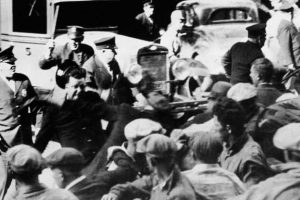Largest Strike Waves in US History

The state of unions in America today is not heartening to the labor movement. In 1983, the first year for which data is available, some 20.1% of the American workforce, representing about 17.7 million, belonged to unions. Last year, there were only about 14 million union workers, accounting for 10.3% of the workforce.
Organized labor has been on the defensive for years, as the economy has shifted away from companies employing traditional blue-collar workers. Twenty-seven states, mostly in the Plains and the South, have enacted right-to-work laws that have diminished union power. (These are the states with the strongest and weakest unions.)
The decline in union membership has undermined the clout of organized labor in America, but that hasn’t stopped workers, both unionized and otherwise, from going out on strike. According to the Washington Post, after a “strike drought” that began in the 1980s, strikes are becoming increasingly common again – as illustrated by 2021’s “Striketober,” which saw an unusually high number of labor actions in the tenth month of the year. Overall in 2021, there were job actions against John Deere, Nabisco, and Kellogg’s, as well as strikes involving nurses in Chicago and Buffalo, faculty at an Oregon college, and graduate students in New York, among others.
Strikes tend to come in waves, spurred by economic downturns and other factors. 24/7 Wall Street has created a list of the largest strike waves in US history, drawing on data from the Bureau of Labor Statistics, as well as Britannica and other online sources.
Click here to see the largest strike waves in US history
Many past job actions ended in violence, such as the Pullman Strike of 1894, which saw 30 people killed, and labor peace continued to be elusive for business in the early part of the 20th century. A number of strikes occurred immediately after both world wars, since many unions had deferred their demands until the conflicts were over. Job actions were undertaken by railroad, steel, and textile workers; miners; and postal workers – among many others. They protested low pay, dangerous working conditions, long hours, and harassment by management, and demanded the right to bargain collectively. Similar concerns persist to this day. (These are the most dangerous jobs in America.)
Sponsored: Find a Qualified Financial Advisor
Finding a qualified financial advisor doesn’t have to be hard. SmartAsset’s free tool matches you with up to 3 fiduciary financial advisors in your area in 5 minutes. Each advisor has been vetted by SmartAsset and is held to a fiduciary standard to act in your best interests. If you’re ready to be matched with local advisors that can help you achieve your financial goals, get started now.
Source: Read Full Article
